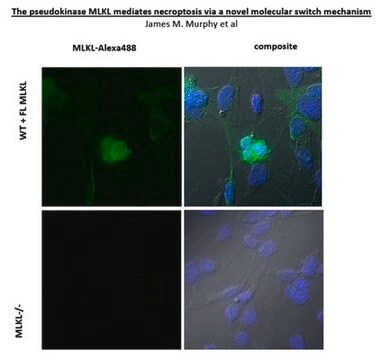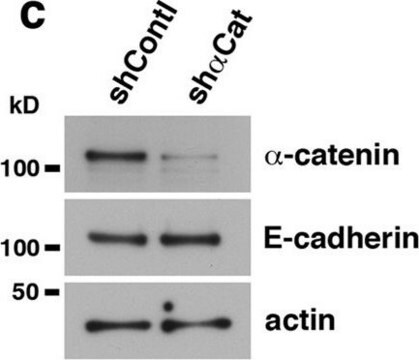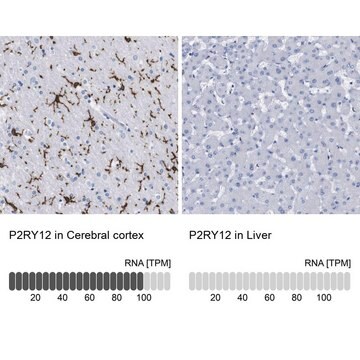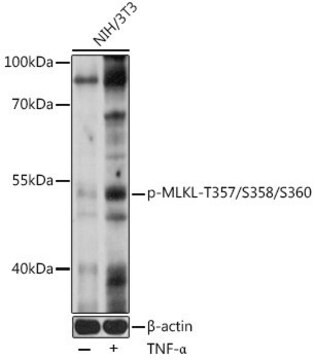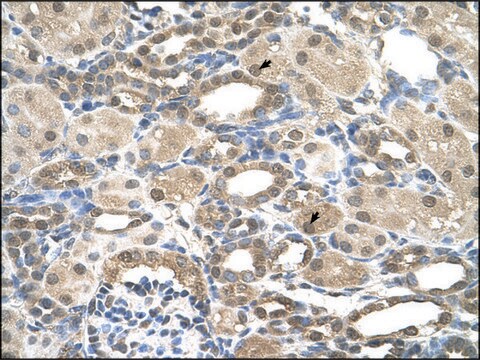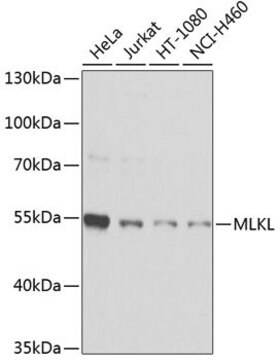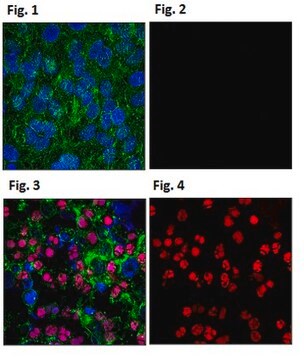MABC1158
Anti-phospho-MLKL (Ser345) Antibody, clone 7C6.1
clone 7C6.1, from mouse
Synonyme(s) :
Mixed lineage kinase domain-like protein
About This Item
Produits recommandés
Source biologique
mouse
Niveau de qualité
Forme d'anticorps
purified antibody
Type de produit anticorps
primary antibodies
Clone
7C6.1, monoclonal
Espèces réactives
mouse
Technique(s)
ELISA: suitable
immunocytochemistry: suitable
western blot: suitable
Isotype
IgG2bκ
Numéro d'accès NCBI
Numéro d'accès UniProt
Conditions d'expédition
ambient
Modification post-traductionnelle de la cible
phosphorylation (pSer345)
Informations sur le gène
mouse ... Mlkl(74568)
Description générale
Spécificité
Immunogène
Application
Immunocytochemistry Analysis: A representative lot detected phospho-MLKL (Ser345) in Immunocytochemistry applications (Rodriguez, D.A., et. al. (2016). 23(1):76-88).
Western Blotting Analysis: A representative lot detected phospho-MLKL (Ser345) in Western Blotting applications (Rodriguez, D.A., et. al. (2016). 23(1):76-88).
Apoptosis & Cancer
Qualité
Western Blotting Analysis: A 1:4,000 dilution of this antibody detected phospho-MLKL Ser345 in 20 ug of lysate from MLKL -/- mouse embryonic fibroblasts expressing doxycycline-inducible wild-type MLKL-Flag-C construct and treated with TNF alpha (10 ng/mL) and Z-VAD-FMK (25 uM).
Description de la cible
Forme physique
Stockage et stabilité
Autres remarques
Clause de non-responsabilité
Vous ne trouvez pas le bon produit ?
Essayez notre Outil de sélection de produits.
Code de la classe de stockage
12 - Non Combustible Liquids
Classe de danger pour l'eau (WGK)
WGK 1
Point d'éclair (°F)
Not applicable
Point d'éclair (°C)
Not applicable
Certificats d'analyse (COA)
Recherchez un Certificats d'analyse (COA) en saisissant le numéro de lot du produit. Les numéros de lot figurent sur l'étiquette du produit après les mots "Lot" ou "Batch".
Déjà en possession de ce produit ?
Retrouvez la documentation relative aux produits que vous avez récemment achetés dans la Bibliothèque de documents.
Notre équipe de scientifiques dispose d'une expérience dans tous les secteurs de la recherche, notamment en sciences de la vie, science des matériaux, synthèse chimique, chromatographie, analyse et dans de nombreux autres domaines..
Contacter notre Service technique